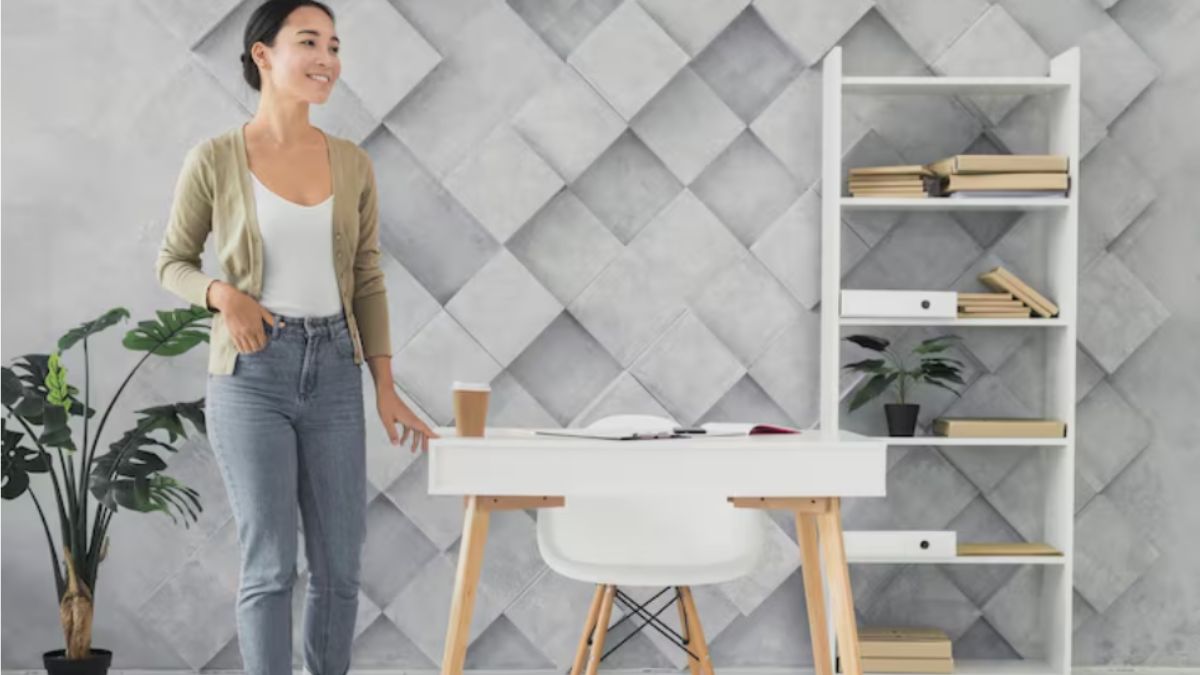Lifestyle
simpciry: Transforming Spaces with Minimalist Aesthetics

In a world buzzing with chaos and clutter, the concept of simplicity stands as a refreshing oasis. Enter simpciry where minimalist aesthetics breathe new life into our living spaces. This movement isn’t just about stripping away excess; it’s an invitation to embrace clarity, focus, and peace in our environments. Imagine walking into a room that feels open and airy, where every piece serves purpose and beauty without overwhelming your senses. As we delve deeper into this enchanting world of minimalism, prepare to discover how less can truly be more when it comes to transforming your home—and your mindset.
What is simpciry?
simpciry is the art of decluttering life. It’s about removing distractions and focusing on what truly matters. When you embrace simplicity, you create space for clarity.
At its core, simplicity celebrates minimalism. This philosophy encourages a clean aesthetic—both in design and lifestyle choices. By stripping away excess, we allow essential elements to shine.
Simplicity isn’t just visual; it affects how we think and feel. A simple environment promotes peace of mind. In such spaces, every piece has purpose.
This concept can manifest in various forms—from fashion to interior design and even daily routines. The beauty lies in its versatility.
By prioritizing quality over quantity, simplicity invites intentionality into our lives. Each choice becomes meaningful when unnecessary clutter fades away.
The Rise of Minimalist Aesthetics
In recent years, minimalist aesthetics have surged in popularity. People are increasingly drawn to clean lines and uncluttered spaces. This shift reflects a broader cultural move towards simplicity.
The rise of digital technology has played a crucial role. With screens dominating our lives, many seek refuge in serene environments that contrast the chaos online. Minimalism offers an escape, providing clarity in both design and thought.
Social media platforms amplify this trend. Influencers showcase beautifully curated minimalist homes that inspire followers to embrace similar styles. The visual appeal is undeniable—less truly can be more.
As urban living becomes more prevalent, space constraints push individuals toward minimalistic solutions. Small apartments demand smart storage and multifunctional furniture that aligns with a simpler lifestyle.
This aesthetic isn’t just about looks; it’s also a mindset focused on mindfulness and intentionality. As we prioritize experiences over possessions, the allure of simplicity only grows stronger.
The Benefits of a Simplistic Space
A simplistic space offers clarity and calm. With fewer distractions, your mind can focus on what truly matters. This simplicity promotes relaxation and reduces stress.
Minimalist environments often feel more spacious. When clutter is minimized, rooms seem larger and more inviting. This openness fosters creativity and enhances productivity.
Another advantage is easier maintenance. Less furniture means less dusting, vacuuming, and organizing. A tidy space contributes to a peaceful state of mind.
Moreover, embracing simplicity encourages intentional living. Each item in the room holds significance, leading to mindful choices about possessions.
Simplicity also connects us with nature by allowing natural light to flow freely within our spaces. It creates a serene atmosphere that invites tranquility into daily life.
Adopting a simplistic approach transforms not just your space but also how you experience it day by day.
How to Achieve a Simple and Minimalist Design
Achieving a simple and minimalist design starts with decluttering. Remove unnecessary items that don’t serve a purpose or bring you joy. A clean slate sets the stage for true simplicity.
Next, focus on neutral color palettes. Soft whites, greys, and earthy tones create calm spaces. They also enhance natural light, making rooms feel more open.
Choose furniture wisely. Opt for functional pieces with sleek lines and minimal ornamentation. Multi-purpose furniture can save space while adding practicality to your design.
Incorporate negative space strategically. This allows elements to breathe and gives the eye a resting place amidst visual complexity.
Add personal touches sparingly—perhaps one striking artwork or an elegant plant can elevate the atmosphere without overwhelming it. Each choice should reflect your style while maintaining simplicity at its core.
Incorporating Simplicity in Different Areas of the Home
In the living room, embrace open spaces and natural light. Choose furniture that is functional yet stylish. A simple coffee table or a sleek sofa can create an inviting atmosphere without overwhelming the senses.
In the kitchen, think about decluttering countertops. Keep only essential appliances on display and store everything else away. Use minimalistic dishware to maintain an airy feel while cooking.
The bedroom should be a sanctuary of peace. Opt for neutral colors and organic materials in bedding to promote relaxation. Limit décor items to just a few personal touches that resonate with you.
For bathrooms, clean lines are key. Utilize storage solutions like baskets or shelves that blend seamlessly into your design scheme. Simple accessories such as plants can add life without cluttering the space.
Every area of your home benefits from thoughtful simplicity, creating an environment conducive to serenity and clarity throughout daily life.
Sustainable and Eco-Friendly Aspects of Simplicity
Embracing simplicity often leads to a more sustainable lifestyle. When spaces are stripped of excess, there’s less demand for resources. This shift can significantly reduce waste.
Choosing minimalist furniture made from eco-friendly materials contributes to a greener planet. Items crafted from reclaimed wood or recycled metals resonate with the principles of simplicity and sustainability.
Moreover, a simplified space encourages mindful consumption. With fewer possessions, individuals tend to invest in quality over quantity, opting for durable products that last longer.
Natural light plays an essential role in simplistic design as well. By maximizing daylight, energy consumption decreases while creating a warm atmosphere in homes.
Incorporating plants adds life without cluttering your space. They improve air quality and bring nature indoors—perfect examples of harmony between simplicity and sustainability.
Conclusion
Simplicity is more than just a design choice; it’s a lifestyle. Embracing minimalism through simpciry has the power to transform not only your space but also your mindset. A clutter-free environment fosters clarity and calm, allowing you to focus on what truly matters.
As you explore the beauty of minimalist aesthetics, consider how each element in your home contributes to that serene atmosphere. Make intentional choices with furniture, colors, and decor that resonate with simplicity and purpose.
Remember, incorporating sustainability into this journey adds an extra layer of meaning. Opting for eco-friendly materials aligns perfectly with the ethos of living simply while being kind to our planet.
Whether you’re beginning from scratch or looking to revamp existing spaces, simpciry invites creativity within constraints. It encourages exploration without excess—finding joy in every carefully curated detail. As you embark on creating simplistic environments, allow yourself room for discovery—the art of living beautifully often lies in embracing less rather than more.
Lifestyle
3 Tips for Grooming Nervous or Anxious Dogs

Some dogs go into the tub like it is playtime. Others shake, hide, or freeze when they see a brush. But when it comes to grooming a nervous dog, it takes more than skill. You have to deal with patience and care. So that grooming should not feel like a battle between you and your furry friend. With some right tricks and tips, you can turn a stressful grooming experience into a great time. Here are five tips to help you groom even the most anxious dogs with ease.
1. Create a Calm and Quiet Environment
The mood of the space sets the tone for the grooming session. Loud dryers and sharp clanks can make even a calm dog feel trapped. So you must try to keep things soft and still. Play calm tunes to fade out the harsh sounds of tools like the dryer and clipper.
Moreover, before you start, let the dog sniff the tools. This will help them feel safe. During the grooming session, you must speak low and slow. Avoid fast moves or loud laughs, as your calm vibe will pass on to the dog.
2. Seek Help from Professionals
If your dog’s fear feels too strong to handle, it is better to take professional help. Some experts are trained to work with anxious pets. They know tricks to calm tense dogs and can guide you on what helps or harms.
You must look for groomers who offer slow and fear-free care, such as those from Woof Gang Bakery & Grooming. They offer the best services for dog grooming in Shaker Heights and can help your anxious furry friend in the best possible way. Their experts know how to move with patience and keep the pet at ease. They even use special tools or quiet clippers that are especially made for shy pets.
However, if your dog’s fear is deep, you must talk to a vet. They will check if there is pain, past trauma, or a health issue behind the anxiety. Sometimes what seems like fear could be pain from mats, ear issues, or skin burn. And a professional’s eye can spot what you might miss.
3. Use Positive Enforcement
Fear fades when joy takes its place. Dogs learn fast when they earn treats, hugs, or praise. Giving small treats during each step of the grooming can make a significant difference. A pat on the head always works, so you can try this positive act with your dog.
You must start slowly. Brush one spot, and then give a treat. Trim one nail and give a treat again. In this way, the dog will learn that the comb or clipper will bring snacks. Now the sound of the tools may not scare them anymore.
If your furry friend pulls away during the grooming session, never scold or shout. Remember, their fear will not fade through force, and it will grow instead. So keep your tone kind and patient. It is okay if the session takes longer. Your goal is not saving time; it is ensuring peace.
Conclusion
Grooming nervous or anxious dogs requires patience, empathy, and the right techniques. By creating a calm environment, seeking professional help when needed, and using positive reinforcement, you can transform grooming from a stressful task into a reassuring experience. These practices not only help dogs feel safe but also strengthen the bond between pet and owner. In the end, a gentle approach ensures that grooming becomes a moment of care and trust rather than fear.
Lifestyle
The Future of Urban Living: How Green Roofs Transform Cities

Rapid urbanization is transforming landscapes worldwide, often replacing green spaces with heat-trapping surfaces that strain both infrastructure and communities. Among the leading solutions for healthier, more resilient cities are green roofs—vegetated rooftops that introduce living systems into built environments. Beyond their visual appeal, these innovative structures deliver functional benefits, making for cleaner air, cooler cities, and safer stormwater management. For property owners and developers seeking practical ways to green their rooftops, eco roofing services offer tailored solutions for both new builds and retrofits.
The advantages of green roofs extend beyond their environmental impact, encompassing economic, regulatory, and even cultural aspects of city life. In urban centers where green spaces are scarce, these living rooftops serve as vital ecosystems that enhance air quality, lower energy costs, and provide natural habitats for wildlife. Thoughtful integration of green roofs can transform city skylines, turning barren rooftops into lush havens that help cities thrive in a rapidly changing world.
As awareness grows about issues such as climate change, the urban heat island effect, and biodiversity loss, green roofs are becoming centerpieces of sustainable city planning. Governments and businesses are increasingly turning to these installations for their blend of ecological and economic benefits. Whether part of a municipal mandate or a developer’s vision for innovation, green roofs are reshaping the way cities adapt and grow.
These remarkable systems also enable cities to achieve their environmental goals and promote community well-being. Insights from case studies around the world show that well-designed green roofs are essential tools in urban sustainability toolkits, paving the way for cleaner, greener, and more livable futures.
Combating the Urban Heat Island Effect
In densely built areas, conventional roofing materials such as asphalt and concrete absorb and radiate heat, significantly elevating local air temperatures compared to outlying areas—a phenomenon known as the urban heat island effect. Green roofs remedy this by covering heat-absorbing surfaces with vegetation. Through processes like evaporation and shading, green roofs can reduce ambient temperatures by as much as 20°F and lower roof surface temperatures by up to 56°F, according to the U.S. Environmental Protection Agency. This cooling not only creates more comfortable living conditions but also directly reduces the need for air conditioning, cutting energy costs and emissions.
Enhancing Stormwater Management
Urban areas struggle with rapid stormwater runoff due to the prevalence of impermeable surfaces. This leads to overwhelmed sewers, increased flooding, and polluted waterways. Green roofs address this issue by holding and slowly releasing rainwater, thereby reducing runoff volumes and easing the burden on drainage systems. For example, Loyola University Chicago’s green infrastructure diverts an estimated 19 million gallons of water from city sewers annually, making a significant contribution to the city’s stormwater management efforts.
Improving Air Quality
Vegetated rooftops act as natural air filters, capturing airborne particulates, absorbing carbon dioxide, and helping to regulate urban climate. By integrating layers of plants and specialized growing media, green roofs remove toxins from the atmosphere, benefiting both human residents and ecosystems. This filtration function is especially valuable in congested cities, where air pollution from vehicles and industry often reaches hazardous levels. Research from National Geographic highlights that green roofs can measurably reduce concentrations of airborne pollutants and improve urban air quality.
Supporting Urban Biodiversity
Green roofs serve as microhabitats that help preserve and restore biodiversity. By mimicking natural environments, they provide safe havens for pollinators, birds, and beneficial insects that are otherwise displaced by urban development. Cities like London have documented diverse wildlife thriving in rooftop ecosystems; for instance, the Canary Wharf green roofs host endangered black redstart birds and more than 200 insect species. These installations form stepping stones across built-up areas, reconnecting fragmented ecosystems and supporting the broader health of city environments.
Boosting Energy Efficiency
Green roof layers provide strong thermal insulation, protecting buildings from the extremes of hot and cold. Their vegetation cover and soil buffer limit summer heat gain through shading and evaporation while reducing winter heat loss. This dual benefit substantially decreases the need for artificial heating and cooling—one of the highest energy drains in high-rise buildings. Over time, property owners realize both direct utility savings and reduced greenhouse gas emissions through wise green roof choices.
Extending Building Lifespan
The structure of a green roof not only supports plant growth but also shields the underlying building membrane from damaging ultraviolet radiation and drastic temperature swings. This protection slows deterioration, minimizes maintenance needs, and extends the life of roofing materials. While traditional roofs often require replacement every 15 to 20 years, high-quality green roofs can last four to five decades, making them a wise investment for both economic and environmental reasons.
Policy Initiatives and Global Adoption
Recognizing the broad benefits of green roofs, municipalities are implementing forward-thinking policies to encourage or even mandate their use. Toronto was the first North American city to require green roofs on new commercial developments in 2009, resulting in rapid and widespread adoption. Chicago and other cities have followed with incentives and building codes designed to reward the integration of eco-friendly rooftops. Globally, cities are adapting these approaches to their own unique challenges and environments, making green roofs a foundational component of sustainable urban design strategies.
Conclusion
Green roofs are revolutionizing how urban environments respond to the demands of a changing climate and growing populations. They transform rooftops from wasted spaces into productive, living landscapes that deliver measurable ecological, economic, and social gains. With more cities prioritizing the installation of green roofs, urban communities worldwide can look forward to cleaner air, cooler neighborhoods, improved resilience against climate extremes, and vibrant biodiversity—ensuring that tomorrow’s cities are truly built to thrive.
Lifestyle
Add Character to Your Living Room with Designer Cabinets

Your living room is the space in the house where you entertain guests. It is often the most well-designed room in the house because you want to impress your guests and loved ones. You want to convey your preferences and sense of style through the living room décor. Every item and curios used in that room portrays your personality. Your choice of furniture pieces, center table, TV units, and designer cabinets says a lot about you. Hence, you need to be very careful about what you choose. Only the very best matters.
- Designer cabinets: A peek into your personality
A great way to enhance the overall look and feel of the living room is by installing designer cabinets. And when it comes to these cabinets, a tailored solution is always the best solution. Why purchase run-of-the-mill products when you can achieve a distinct and different style through the designer ones? Look for experts in this field. Contact service providers who are well-known and offer quality solutions at interesting rates. StoneHill Cabinetry is one such service provider.
- Displays books, curios, and other items in the designer cabinets
You have an interesting book collection and want to display it, but you are not interested in a regular bookcase. Opt for designer cabinets. You will be able to flaunt your wide range of different books without having to settle for the standard bookshelf. Take a look at the cabinets with glass doors. Display your books in this cabinet. Dirt and dust will not be able to accumulate on them, and yet the onlookers will be able to marvel at your extensive collection.
- Designer cabinets are great for storing your belongings
Most of us have an extensive collection of items that we don’t want to discard. But due to the lack of space, you don’t know where to keep them. Why worry when you have designer cabinets? You can store all your belongings in these cabinets and secure them with a lock. But keep one thing in mind. These cabinets should be incorporated into the living room in a way that makes them an integral part of the décor. How about a cabinet below the side table? None of your guests will open this cabinet, and yet you have a great space to store your items.
- Display your collection of photo frames in these cabinets
If you are one of those who still have old photo frames, then these cabinets are the ideal place to display them. Opt for open cabinets. Place the photo frames in the different racks. Arrange the frames in a haphazard manner or in a line to achieve a distinct look. Ensure that you choose offbeat photo frames to capture the viewer’s attention. And since these cabinets are installed on the wall, kids will not be able to touch the photo frames. They will remain safe and secure at all times.
Summing it up
Every house tells a story, and your living room is the main character. Ensure that the room meets expectations. Contact one of the leading cabinet makers in the city and inform them about your requirements and specifications so that they can provide the best solution tailored to your needs. Ask them to provide you with multiple designs before they proceed with creating the final design.
-

 Entertainment6 months ago
Entertainment6 months agoSflix: How It’s Changing the Way We Watch Movies and TV Shows
-

 Blog4 months ago
Blog4 months agohanime1: The Ultimate Destination for Anime Lovers
-

 Technology7 months ago
Technology7 months agoSimpcitt: The Rise of a Unique Online Community
-

 Entertainment5 months ago
Entertainment5 months agoCrackstreams 2.0: The Future of Free Sports Streaming?
-

 Bills6 months ago
Bills6 months agoWhy Does My Instagram Reel Stop Getting Views After One Hour? How to Fix It?
-

 80s7 months ago
80s7 months agoFavorite 100 Songs of the 80s: (#1) Michael Jackson – Billie Jean
-

 Technology6 months ago
Technology6 months agoAnon Vault: Protecting Your Digital Footprint
-

 Blog6 months ago
Blog6 months agoSimpcitu: The New Age Trend Shaping Online Interactions
